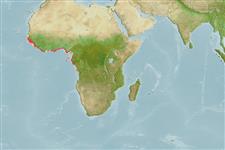>
Clupeiformes (Herrings) >
Dorosomatidae (Gizzard shads and sardinellas)
Etymology: Sardinella: Latin and Greek, sarda = sardine; name related to the island of Sardinia; diminutive (Ref. 45335); rouxi: Named in honor of Charles Roux, director of the 'Centre Océanographique de Pointe-Noire' (Ref. 86940).
Eponymy: Professor Dr Charles Roux (d: 1920) was a French marine zoologist. [...] (Ref. 128868), visit book page.
More on author: Poll.
Environment: milieu / climate zone / depth range / distribution range
Écologie
marin; saumâtre; profondeur 0 - 50 m (Ref. 188). Tropical; 17°N - 10°S, 18°W - 14°E (Ref. 188)
Atlantic Ocean: Eastern Atlantic Ocean from Senegal southward to Congo, possibly to northern Angola (Ref. 188, 5286, 81269, 81631).
Taille / Poids / Âge
Maturity: Lm ? range ? - ? cm
Max length : 16.0 cm SL mâle / non sexé; (Ref. 188); common length : 13.0 cm SL mâle / non sexé; (Ref. 188)
Épines dorsales (Total) : 0; Rayons mous dorsaux (Total) : 16 - 19; Épines anales: 0; Rayons mous anaux: 16 - 21. Diagnosis: Body moderately deep, belly fairly sharply keeled (Ref. 188). Lower gillrakers 30-40 (Ref. 188). A black or golden spot behind gill opening; upper part of pectoral fin dusky; caudal fin pale yellow with dusky hind margin (Ref. 188). Sardinella rouxi resembles S. maderensis, which has more gillrakers and a grey caudal fin, its tips almost black (Ref. 188). It is distinguished from small S. aurita by having 1 unbranched and 7 branched pelvic fin rays vs. 1 unbranched and 8 branched in S. aurita, and no black spot on hind part of gill cover (Ref. 188).
Sardinella rouxi is found in inshore waters and along beaches, forming schools (Ref. 188).
Life cycle and mating behavior
Maturité | Reproduction | Frai | Œufs | Fécondité | Larves
Whitehead, P.J.P., 1985. FAO Species Catalogue. Vol. 7. Clupeoid fishes of the world (suborder Clupeoidei). An annotated and illustrated catalogue of the herrings, sardines, pilchards, sprats, shads, anchovies and wolf-herrings. FAO Fish. Synop. 125(7/1):1-303. Rome: FAO. (Ref. 188)
Statut dans la liste rouge de l'IUCN (Ref. 130435: Version 2024-1)
Menace pour l'homme
Harmless
Utilisations par l'homme
Pêcheries: intérêt commercial mineur
Outils
Articles particuliers
Télécharger en XML
Sources Internet
Estimates based on models
Preferred temperature (Ref.
123201): 24.4 - 28, mean 26.8 °C (based on 66 cells).
Phylogenetic diversity index (Ref.
82804): PD
50 = 0.5000 [Uniqueness, from 0.5 = low to 2.0 = high].
Bayesian length-weight: a=0.00851 (0.00399 - 0.01817), b=3.05 (2.88 - 3.22), in cm total length, based on LWR estimates for this Genus-body shape (Ref.
93245).
Niveau trophique (Ref.
69278): 2.9 ±0.3 se; based on size and trophs of closest relatives
Résilience (Ref.
120179): Haut, temps minimum de doublement de population inférieur à 15 mois (Preliminary K or Fecundity.).
Fishing Vulnerability (Ref.
59153): Low vulnerability (10 of 100).
